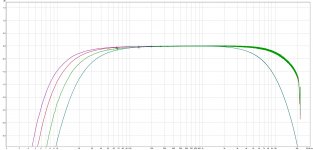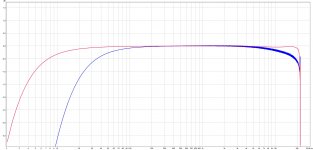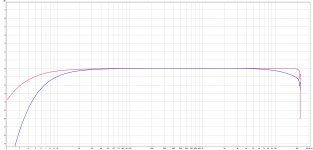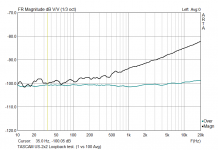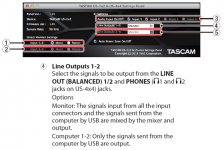So basically, what you're doing is the measurement outlined in section 4.2 of the manual?
Yes, it is a resolution measurement from chapter 4.2.
It was shown that results can be degraded if we have ground loop or other type of signal degradation in dual channel measurement .
One thing is important to note. From our discussion here it follows like ground loop exist only in dual channel measurements. It also exist in single channel measurements when we measure frequency response of the sound card AD/DA converters. A ground decoupling is always welcomed.
In all sound cards there is common ground plane for input and output channels. When we make loop-back connection (in unbalanced configuration) we make ground loop with cable ground. Decoupling means breaking ground on input or output (and connecting break with small resistor: 100-1000 ohms value).
Ivo
Souncard problem
Maybe I need some explanation why I choose Steinberg UR22 and Focusrite Scarlett 2i2 to demonstrate problem in measurement of FR.
They are representative for problems that we have when using sound cards:
1) 2i2 has large input crosstalk
2) UR22 has large LF noise
Still, we can use both for acoustical measurements:
- 2i2 work good in single channel mode (other channel not connected), while dual channel mode has restricted dynamic range.
- UR22 works good with PN noise excitation and averaging, as averaging reduce influence of noise.
I got some reports from other user that had crosstalk problem also with UR22.
Ground loop problem largely depends on length of cables and on electronic environment that generate EMI. It can arise with all sound cards. I have shown how ground loop can be eliminated, by decoupling I/O ground, as it was done in ARTA measurement box, described in application note 1.
Ivo
Maybe I need some explanation why I choose Steinberg UR22 and Focusrite Scarlett 2i2 to demonstrate problem in measurement of FR.
They are representative for problems that we have when using sound cards:
1) 2i2 has large input crosstalk
2) UR22 has large LF noise
Still, we can use both for acoustical measurements:
- 2i2 work good in single channel mode (other channel not connected), while dual channel mode has restricted dynamic range.
- UR22 works good with PN noise excitation and averaging, as averaging reduce influence of noise.
I got some reports from other user that had crosstalk problem also with UR22.
Ground loop problem largely depends on length of cables and on electronic environment that generate EMI. It can arise with all sound cards. I have shown how ground loop can be eliminated, by decoupling I/O ground, as it was done in ARTA measurement box, described in application note 1.
Ivo
This is a good tutorial with regards to soundcards. I'm not sure most folks appreciate all the variables and problems that can be present......especially with the input circuitry. Various gain and loading re-configurations depending upon the type of plug you use.......appropriate setting of the input level controls/pads.....etc, etc.
Dave.
Dave.
Last edited:
I noticed a difference when playing with the two volume controls on the Steinberg UR22 and Focusrite 2i2. They were very sensitive to where the knops where turned. I have seen it with other cheap sound cards too. Can someone explain this? I see some variation with my more expensive Sound Devices USBPre-2 as well, but far less.
Here's the Steinberg with different volume settings:

Here's the Focusrite with different volume settings:

If I remember correctly, this was the best I achieved with both.

Here's the Steinberg with different volume settings:
Here's the Focusrite with different volume settings:
If I remember correctly, this was the best I achieved with both.
Attachments
Hi Ivo,As you see result in single channel mode is almost excellent. What happens in dual channel mode. There are several possible source of errors:
1) in loopback mode (in unbalanced connection) we have ground loop (that is why I decouple I/O ground with 1k resistor in ARTA measurement box)
2) soundcard input channels have large crosscoupling
3) reference signal has high distortion
4) sometimes bad contacts also make problems
Wouldn't those factors also apply for the dual channel PN measurement?
I had in mind another potential contribution when I suggested trying single channel mode, the decreasing LF content in the reference channel as frequency approaches zero and the difficulty of (in effect) dividing one ever smaller level by another, with noise becoming increasingly dominant, plus the additional complication of the input and reference channels almost certainly having slightly different LF rolloff points due to component tolerance. Are those not factors?
Bjorn,
I do not have ur22 or 2i2 shematics, but it seems they are coming from the same outsourcing development.
What you have measured can probably be explained with some capacitor in potentiometer path.
John,
yes all these error factors apply for pseudo noise excitation as well, but if errors come from noise or if captured signal is low then averaging with noise gives better results than swept sine - the PN noise has random phase properties that distribute error equally over all frequencies.
The worst situation is when we have input crosstalk - then noise and swept sine are equally not efficient.
In one my paper I suggest the use of single channel mode with soundcards that has high low frequency cuttoff. In case of dual channel measurements then it happens what you were noticed, plus effect of difference in cutoff frequency. In practice I have noticed that this effect are acceptable in acoustical dual channel measurements if system has cutoff bellow 5Hz.
So, we always have to pay some price: in dual channel we get proper phase response but with some errors (ripple) on low frequencies. In practice this ripple is lower in audio band (20-2000Hz) than frequency response bias obtained with single channel mode.
Dual channel also has problem close to fs/2 frequency as antialiasing filter
gives very low level of signal. The result is excesive ringing near fs/2. In ARTA user can force filtering of this ringing.
You are making use of other channel for delay compensation, the same does ARTA with MLS signal, but only dual channel setup gives true phase. response. That is why we need dual channel measurement.
Ivo
I do not have ur22 or 2i2 shematics, but it seems they are coming from the same outsourcing development.
What you have measured can probably be explained with some capacitor in potentiometer path.
John,
yes all these error factors apply for pseudo noise excitation as well, but if errors come from noise or if captured signal is low then averaging with noise gives better results than swept sine - the PN noise has random phase properties that distribute error equally over all frequencies.
The worst situation is when we have input crosstalk - then noise and swept sine are equally not efficient.
In one my paper I suggest the use of single channel mode with soundcards that has high low frequency cuttoff. In case of dual channel measurements then it happens what you were noticed, plus effect of difference in cutoff frequency. In practice I have noticed that this effect are acceptable in acoustical dual channel measurements if system has cutoff bellow 5Hz.
So, we always have to pay some price: in dual channel we get proper phase response but with some errors (ripple) on low frequencies. In practice this ripple is lower in audio band (20-2000Hz) than frequency response bias obtained with single channel mode.
Dual channel also has problem close to fs/2 frequency as antialiasing filter
gives very low level of signal. The result is excesive ringing near fs/2. In ARTA user can force filtering of this ringing.
You are making use of other channel for delay compensation, the same does ARTA with MLS signal, but only dual channel setup gives true phase. response. That is why we need dual channel measurement.
Ivo
Hi Pano,
the problem is not so big. Almost all high quality audio pro sound cards are working good in single channel and dual channel mode: from expensive monsters like RME and Lynx cards to more affordable M-Audio, Roland or EMU cards.
Steinberg UR22 and Scarlett 2i2 are really cheap cards. As we have seen they have problem of input channels noise or crosstalk. But, they can be succesfully used in single channel setup. The same holds for cards with cheap Realtek or TI codecs.
Ivo
the problem is not so big. Almost all high quality audio pro sound cards are working good in single channel and dual channel mode: from expensive monsters like RME and Lynx cards to more affordable M-Audio, Roland or EMU cards.
Steinberg UR22 and Scarlett 2i2 are really cheap cards. As we have seen they have problem of input channels noise or crosstalk. But, they can be succesfully used in single channel setup. The same holds for cards with cheap Realtek or TI codecs.
Ivo
When you were performing the dynamic range tests where do you have the input gain set?Steinberg UR22 and Scarlett 2i2 are really cheap cards. As we have seen they have problem of input channels noise or crosstalk. But, they can be succesfully used in single channel setup.
Had you tested the TASCAM US-2x2 yet? I have access to one for a bit and would be happy to run some tests if you let me know what you are interested in.
Attached is a quick sample of the TASCAM noise floor with and without 100x averaging.
One nice thing I noticed was that there is an option in the driver setting panel to use the digital signal directly for the output rather than the monitor signal which may have some residual from the inputs remaining. I couldn't find a similar setting for the UR22 which always uses the mixed monitor output.
Oh, also a service manual is readily available for the TASCAM.
If interested in seeing schematics, send me PM with contact info.
Attachments
Bolster,
I did not wanted to make list of good card manufacturers, certainly many other firms make good sound cards. TASCAM is very good firm as it has own development and it makes good sound cards. I had US122 but now there is no driver for it. It had very good line input converters, but microphone amplifier had slightly large distortion. As I see in this new affordable series they made better microphone amplifier.
I would recommend ARTA users to buy cards from manufacturers that has their own development of sound cards, as it is some kind of garant for updating firmware and driver.
.-.
In manual I show testing done on line inputs (not on microphone inputs), with gain set to receive full scale -3dB signal (if possible).
Your example show how averaging greatly enlarge dynamic range (wow, 100dB of dynamic range over all audio banwidth was before few years dream even for most expensive Fourier analyzers).
Ivo
Ivo
I did not wanted to make list of good card manufacturers, certainly many other firms make good sound cards. TASCAM is very good firm as it has own development and it makes good sound cards. I had US122 but now there is no driver for it. It had very good line input converters, but microphone amplifier had slightly large distortion. As I see in this new affordable series they made better microphone amplifier.
I would recommend ARTA users to buy cards from manufacturers that has their own development of sound cards, as it is some kind of garant for updating firmware and driver.
.-.
In manual I show testing done on line inputs (not on microphone inputs), with gain set to receive full scale -3dB signal (if possible).
Your example show how averaging greatly enlarge dynamic range (wow, 100dB of dynamic range over all audio banwidth was before few years dream even for most expensive Fourier analyzers).
Ivo
Ivo
Freqency domain 2Ch averaging uses different noise signal for every sequence. Averaging is in frequency domain. It reduces external noise (like time domain averaging) and additionally reduces stationary disturbances and nonlinear distortions - as different noise sequences randomize stationary disturbances and distortion. Only bad side is that it needs more time than time domain averaging.
Ivo
Hi Ivo
Last night I saw this thread and made some test here.I find that the stimulus PN pink may be the most preferable one(adding frequency domain averaging and in dual channel mode) for FR & IR and other like measurements.If in single mode the result will be more inferior,especially using the log swept sine.So always with PN pink for my measurement,other conditions I seldom consider in them,the saying "simple is better"!!
PN vs Sweep
With this statement only I agree also that I have tested
Hi Ivo
Last night I saw this thread and made some test here.I find that the stimulus PN pink may be the most preferable one(adding frequency domain averaging and in dual channel mode) for FR & IR and other like measurements.If in single mode the result will be more inferior,especially using the log swept sine.So always with PN pink for my measurement,other conditions I seldom consider in them,the saying "simple is better"!!
With this statement only I agree also that I have tested
An externally hosted image should be here but it was not working when we last tested it.
Here's the test
An externally hosted image should be here but it was not working when we last tested it.
Give it a try.Maybe several times' experiments can provide reliable result.
An externally hosted image should be here but it was not working when we last tested it.
Give it a try.Maybe several times' experiments can provide reliable result.
Still does not work
Still does not work
It can be seen now on my Pc,try again
